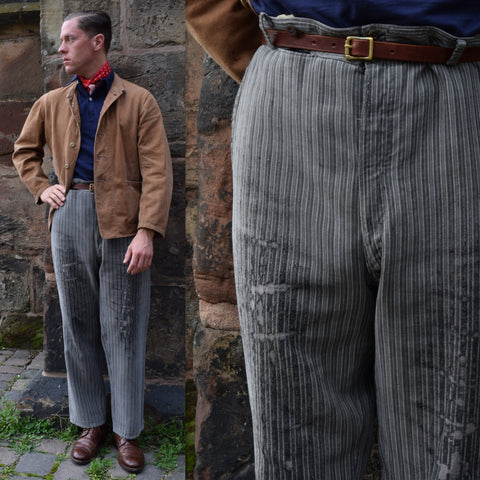Cotton Workwear

Classic Cotton Workwear
From the plains of Arizona to the meatpacking factories of Chicago; from the labourers 'De Nimes' to the gold miners in the outback of Australia; there is one woven cotton cloth that gentrified the working classes worldwide, elevating their cloths from the flat plain canvas weaves, meaning they were still easily identifiable as a workman, and blurred the lines into a washable weave that could be worn at work and in town, at evenings and weekends and performed as a functional cotton suit for all occasions.
In the world of the vintage work wear collector and enthusiast, there is one cloth that is instantly rerecognizable and highly desirable: the multi-striped workwear cotton cloth - in combinations of grey, black and white - and commonly associated with working men of the late 20th century.



The origins of this iconic striped cotton workwear cloth go back to the 19th century when, throughout Europe and the USA, the pattern was adopted from the striped 'morning suit' trousers of formal daywear and made into workwear.


There is a certain irony in the way that the style of expensive high-quality wool or cashmere trousers, worn by gentlemen, were copied in cotton to become the favoured cloth of farmers and factory workers. The use of heavy cotton to weave the cloth meant the trousers retained their elegance yet could withstand the rigours of hard manual labour and thus be worn in town after a hard days graft and still look respectable.


Ever since the emergence of a worldwide market for vintage clothing, in particular, vintage workwear, large amounts of this striped clothing has become sought after. Some examples date back to the early years of the 20th century and arrive at their new owners complete with ornate 100 year old sewn on company paper label other comes with authentic dust, dirt and oil stains.
In its purest unwashed form, complete with patches and rough hand-sewn repairs, or engrained with the accumulated sweat - or worse - of their original owners, such garments are only for the most dedicated collector. Fortunately, the fabric remained popular for so long that some lucky vintage enthusiasts have been able to find deadstock original garments that have emerged unworn from closed down warehouses and shops. However, these original garments, whether pristine or encrusted with a century of worth of grime, are only found in a limited range of sizes, usually tiny. As a result, the long-limbed or broad chested customer cannot expect to find the clothes they desire.


Although the pattern is most commonly associated with trousers, it was also used for workmen's jackets, caps and waistcoats. Just as the stripes were copied from formal trousers, the pattern for some working jackets were based on the stylish suits of mid-20th century youth fashions, adding a belt back and rear pleats to give an elegant silhouette that was more about flair than function. The work jackets differed from more formal styles by removing any interior lining, leaving an easy to wear unstructured jacket. The workman's style also had deep, patch pockets that allowed them to easily carry items they needed for their work.
There were hundreds of different stripe patterns produced by cotton mills, most of them being a darker shade of grey or black as the base colour with interspersed lighter thread woven into it as a broken stripe. Some patterns have both darker and lighter thread woven into the base colour. Aside from the typical grey base, some stripes in shades of brown have turned up as well. Sometimes the striped pattern is outright bold, but most of the time the darker grey dominates over the lighter stripes, resulting in a fairly subtle overall look.


Whilst formal morning trousers were made from hard worsted wool, the workwear variety were not only made from cotton, but the interior of the cloth was flannelised, raked or brushed. This resulted in a rough and tough work fabric that is hardwearing due to its hard finish on the outside, as well as comfortable due to the soft inside that traps warm air. The spongy interior makes the trousers feel like cotton flannel pyjamas when worn. This is the kind of cloth that, like denim, only gets better with frequent wear and washing.



With vintage originals becoming harder to find, and for people who don't want their clothes to smell of mildew and Gauloise, SJC has crafted a worksuit for its customers. We have woven a pattern that is bold enough to be visually catching when seen up close, but subtle enough to blend in when viewed from across the room – thus making sure that the suit will not enter the room before you do. What workers were after was a cloth that would enable them to use it for actual work yet be suitable for dressing up as well. This is a modern dandy style, firmly rooted in the traditions of vintage workwear - perfect for nearly every occastion.